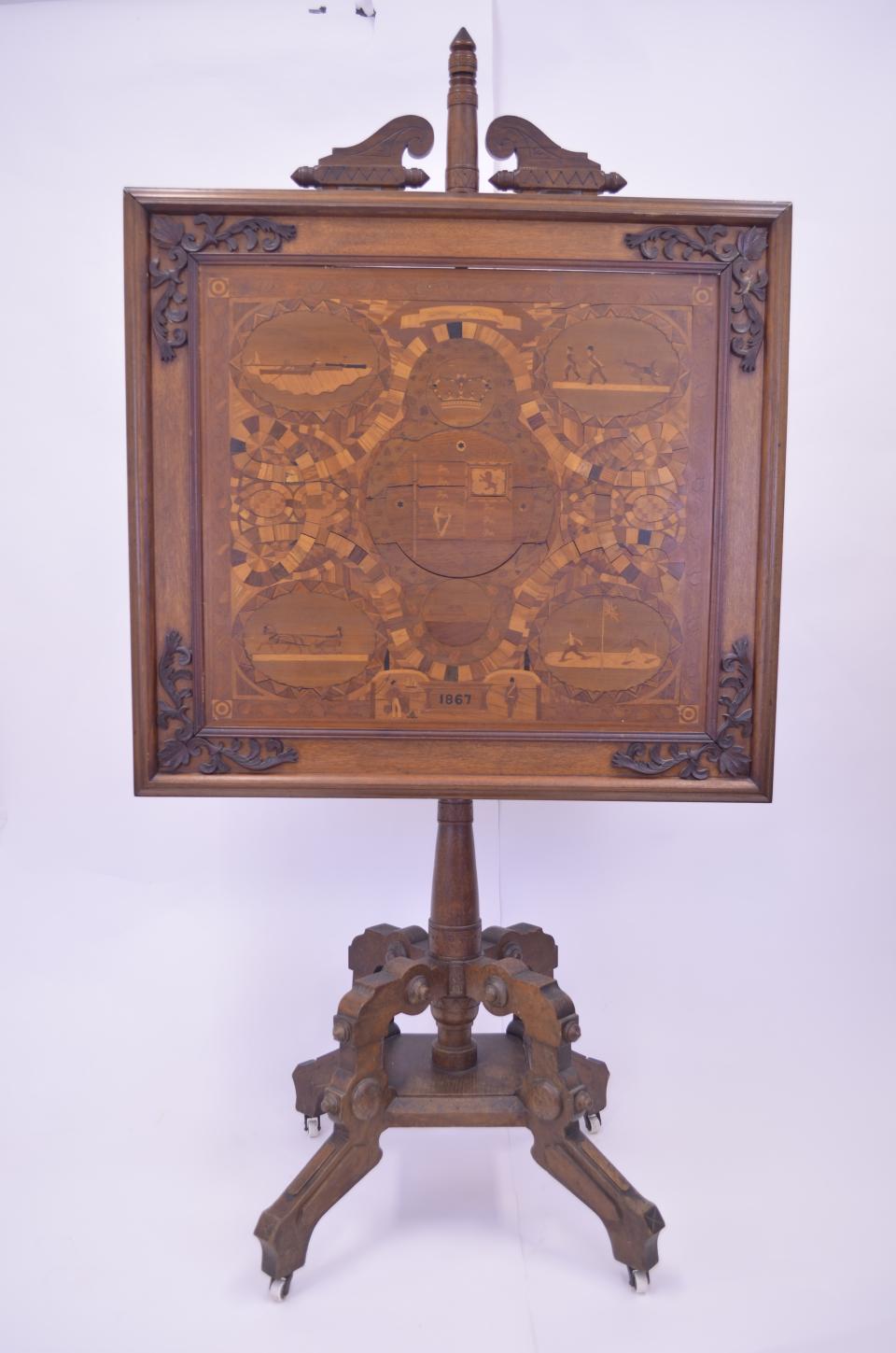
H 177.5 x L 96.7 x W 56.0 x D 7.5
The object consists of a rectangular shaped mosaic, a metal cylindrical bar inlaid vertically in the back of the mosaic that extends above and below connecting to a stand and four legs.
The wooden mosaic is comprised of 3,498 pieces of wood from 120 different specimens of wood. There is a border around the main body of the mosaic that has a decorative maple leaf and foliage relief in each corner. The mosaic itself, consists of four separate Canadian scenes, one in each corner; two crossed-palm leaves above an image of a crown in the centre of the top half of the composition, the Royal Standard of the United Kingdom in the centre, and an image of a beaver above the date "1867" with a depiction of the navy on the proper right and the army on the proper left in the centre of the bottom half. The four Canadian scene are as follows; top left - a man-powered boat race; top right - a skating race with three figures; bottom left - a horse-drawn sleigh ride; and bottom right - a snow-shoe race. There is a band of maple leaves around the interior perimeter, a chequered band passing above and below the coat of arms and branching off to the right and left in a double scroll, and a band around the central images comprised of roses, shamrocks and thistles.
The metal cylindrical bar is inlaid in the back of the mosaic, allowing the mosaic to pivot left and right. The bar extends above and below the mosaic and sits in a carved wooden finial at the top and a cylindrical wooden stand that attach's to the base at the bottom. The base consists of four boldly out thrust cabriole legs that end with ogee bracket feet that sit on caster wheels. A wooden square base attach's at the mid point of each leg, the central stand is secured onto this. There are also two decorative finials that are attached to the top edge of the mosaic, that sit on either side of the carved finial.
Notable pieces of wood include: A piece of black oak between the palm branches and crown that is a piece of the ship the Royal George; the star above the Royal Standard is a piece of Lord Nelson's cabinet, and was on board the Victory at the battle of the Nile; the star on the left is a piece of the ship the Royal George, and the one on the right is a piece of oak procured from the wreck of the Mary Rose. The star below is a piece of oak procured from Nelson's flag-ship Victory.
The mosaic is comprised of 3,498 pieces of wood from 120 different specimens of wood, collected from various parts of the world including England, Ireland, Scotland, Norway, Belgium, France, India, China, East India, Australia, New Zealand, Panama, West Indies, Honduras, United States and Canada.
The pieces of wood on the checkered band that passes above and below the coat of arms, and branches off to the left and right are identified on a newspaper article that was printed in 1867. The piece of black oak between the palm branches and crown should be considered number one, from it counting left and right are the name of each piece of wood.
Left: 1. Royal George, 2. Dogwood, 3. Chinese Pine, 4. Bitternut, 5. Black Cherry, 6. Hazel, 7. Nannyberry, 8. Wildvine, 9. Laburnum, 10. Swamp Willow, 11. Scrub Oak, 12. Alder, 13. Gopherwood, 14. Black Currant, 15. New Zealand Boxwood, 16. Snowball, 17. Rose Tree, 18. Columbo Root, 19. Bamboo, 20. Whin, 21. Brier Root, 22. English Ash, 23. Oak (ship Mary Rose), 24. Bitter-sweet, 25. Australian Cedar, 26. Pear Tree, 27. Couy-ang, 28. Juniper, 29. English Oak, 30. Tea Tree, 31. Lilac, 32. Buttonwood, 33. White Oak (Nelson's ship Victory), 34. Quassia, 35. Aspen, 36. Cassia Locust, 37. Cascarilla, 38. Red Oak, 39. English Walnut, 40. Shetland Beech, 41. Grenadier Wood, 42. English Hazel, 43. Peruvian Bark Tree, 44. Blackthorn, 45. Cinnamon, 46. Barbary Hedge Tree, 47. Peach Tree, 48. Pimento, 49. Locust, 50. Slippery Elm, 51. Cotton Wood, 52. Shetland Birch, 53. White Beech, 54. Red Wood, 55. Hawthorn, 56. Signet, 57. Wild Cherry, 58. Greenheart, 59. Prickly Ash, 60. Camphor Wood, 61. Gooseberry, 62. Grapevine, 63. Elder, 64. Grogga Wood.
Right: 1. Royal George, 2. Yellow Birch, 3. Blue Oak, 4. White Poplar, 5. Red Plum, 6. Spruce, 7. Satin Wood, 8. Sycamore, 9. Laurel, 10. Horse Chestnut, 11. Tamarac, 12. Swamp Elm, 13. Lime Tree, 14. Willow, 15. Blue Beech, 16. Birdseye Maple, 17. Logwood, 18. Wild Gooseberry, 19. Butternut, 20. Curly Maple, 21. Service Berry, 22. Soft Maple, 23. Black Oak, 24. White Pine, 25. Blue Plum, 26. White Birch, 27. Red Pine, 28. Basswood, 29. Black Ash, 30. Larch, 31. Sassafras, 32. Norway Fir, 33. Pine-knot, 34. Whitewood, 35. Walnut, 36. English Elm, 37. Witch Hazel, 38. Black Birch, 39. Boxwood, 40. Lignumvitae, 41. Hemlock, 42. Red Cedar, 43. Hard Maple, 44. Rosewood, 45. White Cedar, 46. Mahogany, 47. Rock Elm, 48. Ebony, 49. Cherry, 50. Malacca Cane, 51. Grey Elm, 52. Apple Tree, 53. Ironwood, 54. White Oak, 55. White Ash, 56. Sumac, 57. Yellow Pine, 58. Chinese Oak, 59. Holly, 60. Fustic, 61. Poplar, 62. Red Beech, 63. Lombardy Poplar, 64. Baytree, 65. Balm of Gilead.
The two specimens of wood from the Shetland Isles are curiosities of great antiquity, being the remains of trees dug out of the moors in the parish of Walls, and are reckoned to be upwards of 1000 years old. The specimen of couy-ang was brought from the island of Cuba, being a portion of a beam taken out of an old cathedral while undergoing repairs, in the village of Cobri.
